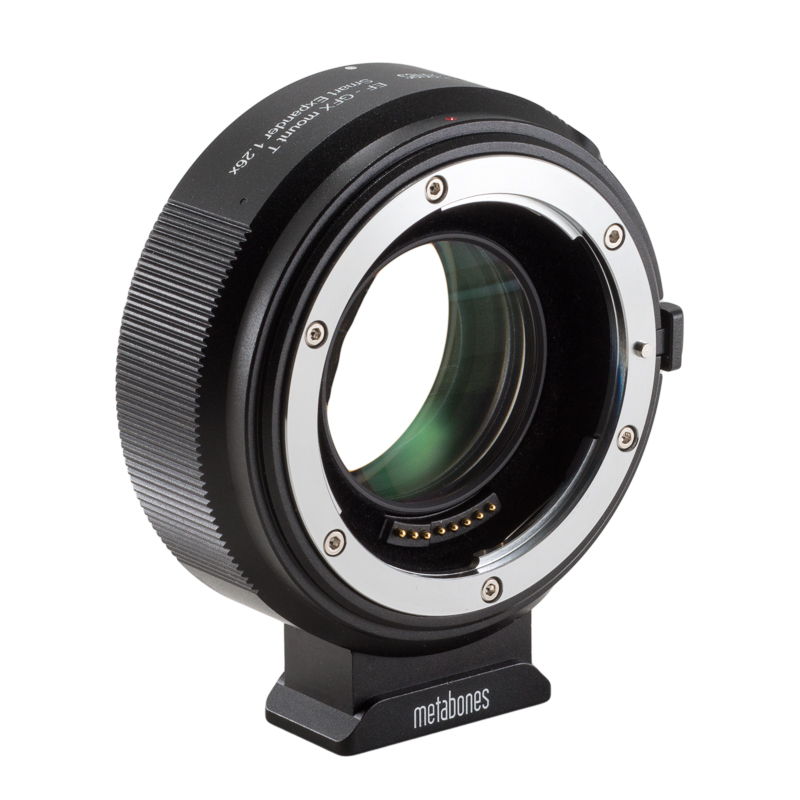Optical
Make Canon EF mount lens to cover the Fujifilm G-mount (GFX series) camera ;
Advanced 5-element/3-group optical design incorporating ultra-high index Lanthanum-based optical glass by Caldwell Photographic in the USA ;
Magnification of lens: 1.26x *
Crop Factor with Fujifilm GFX camera: 1.0x
Electronic
Canon EF mount lens to Fujifilm G-mount camera.
Autofocus. Phase-detection autofocus (PDAF) is supported no matter which AF lens is used. Adapters support PDAF by translating pertinent metadata about the optics between the lens interfaces. In this way, broad support of the widest range of lenses is made possible.
Lens iris/aperture is set by the controls on the camera body.
Optical image stabilization (IS) lens support.
Smooth iris support with the latest Canon (2009+), Tamron (SP series 2013+) and Sigma (2016+) lens models.
Focal length and aperture are adjusted in EXIF (see note 3).
Store EXIF data (lens name, focal length and maximum/minimum aperture) for one manual lens in the adapter.
LED indicator shows communication status.
Powered by camera body. With most lenses, no external power source required.
Mechanical
The tripod foot is detachable and compatible with Arca Swiss, Markins and Photo Clam ball heads.
Flocking to reduce internal reflection.
Aluminum alloy and brass construction with chromium plating.
Satin surface finish.
Detachable Arca-Type tripod foot compatible with Arca Swiss, Markins, and Photo Clam ball heads(clamp directly or attach to quick release plate by a 1/4″-20 screw).
* Note: Aperture values decrease by 2/3 of a stop used in conjunction with this Expander.
Limitations
In some rare cases lens hoods designed for 3:2 may need to be removed for 4:3 use with Smart Expander.
Each lens needs to go through a calibration procedure when first used. Refer to the online user manual on Metabones’ web site for instructions.
Autofocus may have unsatisfactory performance and may not work at all with some lenses
For video autofocus, increasing FOCUS SENSITIVITY and decreasing AF SPEED are required under the AF-C CUSTOM SETTING (MOVIE) menu.
For video, aperture priority or manual exposure is recommended to avoid exposure flickering. EF lenses are not capable of fine-grained control of the aperture required by Fujifilm cameras.
AF+MF and lens aberration correction are not supported.
Some film-era lenses may not be able to achieve sufficient AF accuracy required for digital cameras. Worn lenses with faulty sensors may lead to AF problems on a mirrorless camera even though the lens may appear to function normally on a DSLR.
Aperture diaphragm makes frequent noises with older lenses. Use aperture priority and manual exposure modes, or use a lens which supports smooth iris.
With IS/OS/VC lenses the IS MODE setting is ignored and both SHOOTING ONLY and CONTINUOUS modes behave in the same way which is similar to a Canon camera but different from what Fujifilm OIS lenses do. This is done to maximize IS effectiveness. A negative consequence of this is that there may be no OIS during focus check.
MF Distance Display does not work (although AF Distance Display does, if the lens transmits distance information). Since Metabones has a track record of releasing new firmware updates which significantly improve the features, performance, compatibility and reliability of existing products, these limitations are subject to change in the future. Please refer to the product pages on Metabones’ web site for the most up-to-date disclosure.
Unsupported List
EF-S lens. EF-S lenses require modification to fit or may remain incompatible even after modification.
Lens correction such as peripheral shading, CA and distortion
Focus confirmation “chip” (e.g. Dandelion)
M42 screw mount adapters (see note 3)
Stacking non-Metabones/non-Conurus mount adapters on top (see note 4 and list of lenses which require modification below.)
Description
Metabones Expander 1.26x
The EF – GFX Expander 1.26x allows Canon EF mount lenses to be mounted on Fujifilm GFX camera bodies without getting dark and / or soft corners. The magnification factor of 1.26x perfectly matches the image circle of the full-frame Canon EF lenses to the medium-format sensor of the GFX series cameras, and therefore the diagonal field-of-view (FOV) remains exactly the same.
The optical design consists of 5 elements in 3 groups, incorporating ultra-high index Lanthanum-based optical glass as well as one element made of fused silica, resulting in extremely good performances with professional-grade f/2.8 zoom lenses. For example, a 24-70mm f/2.8 lens becomes a 30-88mm f/3.5 zoom, and a 70-200mm f/2.8 lens becomes an 88-252mm f/3.5 zoom.
Due to the nature of focal extenders, the aperture values decrease by 2/3 of a stop; f/2.8 becomes f/3.5 and f/2 becomes f/2.5. High-speed fixed focal length lenses such as the 50mm f/1.4 will be transformed into a very fast 63mm f/1.8 standard lens for the GFX system.
The EF-GFX mount Smart Expander features Metabones’ electronic integration, including phase-detection autofocus (PDAF), in-body image stabilization (IBIS), optical image stabilization (called IS/OS/VC by various lens manufacturers) and smooth iris. The button on the Smart Expander toggles between auto aperture (programmed exposure or shutter priority) and manual aperture (aperture priority or manual exposure). If a manual lens with no electronics is attached, the button brings up the manual lens selection on the camera body so that focal length can be chosen for correct IBIS operation and EXIF.
Tested Cameras
Fujifilm GFX 50S, GFX 50R and GFX 100
| Tested Lenses | ||||||||||||||||||||||||||||||||||||||||||||||||||||||||||||||||||||||||||||||||||||||||||||||||||||||||||||||||||||||||||||||||||||||||||||||||||||||||||||||||||
|

